#middle persian language
Text
youtube
Old Persian word for "Love".
A boy falls in love with a king's female servant
The story of an ancient love ❤️
The love of the king of ancient Iran
❤️ The Persian word for love 🥰 . The story of an ancient love, almost 1800 years ago in Iran. This is the story of a boy who falls in love with the female servant of the King of Iran and runs away with her.
Finally, this boy named "Ardashir" fights with the king of Iran, defeats him and becomes the king of Iran himself and establishes the Sassanid dynasty.
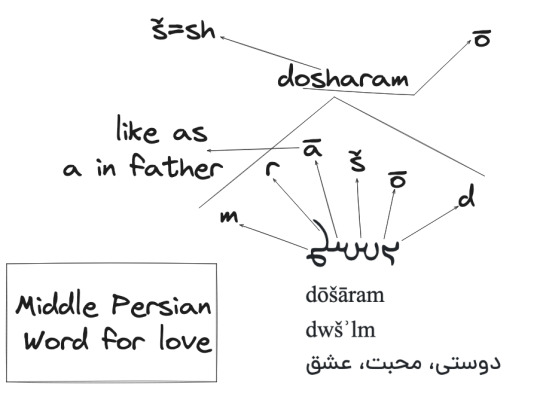
Read More:
Sumerian world for "Love".
History of wine in mesopotamia.
What is the word for love in Akkadian language?
Follow my YouTube channel. Silent tablets documentary, short videos from ancient history.
Follow my Twitter.
#archaeology#ancient mesopotamia#mesopotamia#brief history bites#ancient history#asia history#history of persia#history of iran#history of the sassanid empire#history of the persian empire#middle persian language#iranian peopel#iranian languages#iranian#romantic words#romantic#pahlavi scripts#Youtube#ancient words for love#ancient romantic words
1 note
·
View note
Text
مهر
We have a word in Farsi, "مهر" (pronounced: mehr) that roughly translates to kindness. I was reflecting on this word today and wanted to expand on its relevance.
One of the phrases which uses the word is "مهرت به دلش بشینه" This phrase is directly translated to "May your love sit in their heart," and is a prayer or wish made for lovers or friends. We pray that your beloved loves you/ has kindness in their heart for you.
It's interesting, because when we love someone, we associate even their most negative traits with something positive. We choose to see the best in that person because we have a special sense of kindness in our hearts for them.
The مهر can turn someone's most viscous qualities into things we are willing to look past or even admire. In other cases, lack of مهر can cause us to see someone's most beautiful and incredible traits as something ill intended or malicious.
I just love that there is a word for this concept/idea in Farsi.
235 notes
·
View notes
Text
Farsi Persian vs. Dari Persian: What's The Difference?
Let's start with this: Farsi and Dari are both mutually intelligible dialects of the Persian language. Farsi is the official language in Iran and Dari is one of the two official languages of Afghanistan. Many people consider them to be the same. The question is: are they, in facct, the same?
First, let's consider the similarities.
What's the same?
Farsi (فارسی) and Dari (دری) use the same standard alphabet. This alphabet is a variation of the Arabic alphabet, often called the "Perso-Arabic" alphabet.
The pronunciation difference between Farsi and Dari is said to be similar to the difference between American English and British English.
Adding onto the previous point, the consonants appear to be pronounced the same way
Most of the vocabulary is the same (see below).
The basic grammar is the same.
What's different?
While Farsi and Dari both use the same alphabet, the average literacy rate in Afghanistan is about 46% lower than that of Iran. By consequence, Dari is written considerably less than Farsi.
Dari uses more English loanwords than Farsi. Iranian linguists are seen to be more passionate about preserving Iranian Persian.
Pronunciation-wise, Dari is believed by some Iranians to be the Persian spoken prior to the Soviet invasion.
Generally, Dari uses more Turkish and Mongolian loanwords than Farsi does.
Some everyday vocabulary in the two languages. For example, the word for "thank you" in Dari is "تشكر" (tashakor) which is the same word in Arabic while in Farsi, the word for "thank you" is "مرسی" (mersi) comes from the French word for thank you (merci). Another example of
Dari has more dialects of the language spoken by the several ethnic minorities in Afghanistan. Farsi, on the other hand, has less dialects.
Vowels are often pronounced differently.
Conclusion
In my opinion, Dari and Farsi are (sort of) different languages.
While they possess many similarities, the vocabulary and pronunciation is too big for me to consider them to be two different languages. However, they are not as different as Spanish and Portuguese are. They can be understood with ease, though they are unmistakably different. Another reason why I can consider them to be different languages is that they are spoken in different countries - similar to how Hindi and Urdu are considered to be two different languages.
Do you speak/study either of the languages and have a different opinion? Let me know!
Sources: Discover Discomfort, Britannica (Dari Language), Diplomatic Language Services, Translators Without Borders, Wikipedia (Iranian Persian), Wikipedia (Dari) Britannica (Languages of Afghanistan).
#persian#farsi#dari#lingblr#languages#asia#south asia#middle east#debate#language#world#the world#interesting
13 notes
·
View notes
Text
smn asking if i speak arabic to me bc im persian actually makes me so exasperated i just immidiately lose interest in them at this point . "but it looks like arabic" im never gonna talk to u again at this point i am tired of educating ppl on this !! i feel like a horrible person for it but hhhh
#arabic is a cool language etc but i do not speak it bc persian is its own language !!! and im tired of ppl not knowing that !#like i get that its not their fault and western education brands all of the middle east as arab etc etc#but farsi is in a completely different language family its so . not the same at all . and its insensitive considering the history of the#country . i appreciate arabic as a language but im acc Exhausted of this to the point where i automatically like . switch off towards that#person . idk . maybe its silly but im growing increasingly impatient w it bc in tired of reexplaining over and over again#ive been talking to this person for like a month and they said persian sounds cool and i asked them if theyve ever#heard farsi being spoken and they said no but semetic languages sound cool and like#yeah but bro farsi isnt one of them#its such a small thing ik but its actually Irritating at this point i've lost count of the number of times ive had to give the#no-i-dont-speak-arabic-farsi-is-a-completely-seperate-language-no-just-bc-the-script-is-arabic-doesnt-mean-the-language-is#and i keep having to give the same just bc english and spanish use the same alphabet doesnt mean theyre the same language etc etc
14 notes
·
View notes
Text
Working with a Zoroastrian beta reader for my novel is wonderful and gets complex so so so quickly. It’s fun.
#trying to nail down what I’m calling the language of 6th century peoples is wild#like if we look at Gawain for example he could be speaking a number of things under the Britthonic umbrella#so then we look at Persian Ragnelle & the langauge is technically Middle Persian or Pahlavi but their holy texts were in Avestan & AHHHHH#everyone is communicating telepathically I wash my hands of this#don’t question it it’s fantasy yes historical fantasy but it has to flow as well#this beta reader is helping me find a balance :^)#also they are paid by the way this is way too much work for free#pay the people helping you no exceptions
4 notes
·
View notes
Text
• Mossadegh media: newspaper & magazine articles, editorials
#mossadegh#iran#manchester guardian#the guardian#spelling#misspelling#how do you spell it#iranian#english language#tehran#middle east#foreign policy#britain#linguistics#spelling errors#spelling mistakes#1950's#mohammad mossadegh#persian
0 notes
Text
Arash - Tike Tike Kardi
2005
Arash Labbaf is an Iranian-Swedish singer, entertainer, and producer. He represented Azerbaijan along with Aysel in the Eurovision Song Contest 2009, finishing third with the song "Always". He is also one of the judges of Persia's Got Talent. He has said that the reason he chooses to sing in his native language is because of his "deep attachment to Iran and Persian culture."
His debut album Arash - on which "Tike Tike Kardi" appears - was released in 2005, after he had finished college. His singles made it to the hit lists around Europe, and the videos garnered significant airplay on more than 20 MTV outlets worldwide. In addition to successes in his home countries' music charts, Arash has had hits notably in Eastern European and South-East European charts like Russia, Ukraine, Greece, Bulgaria, Poland, Hungary, Georgia, Armenia, Azerbaijan, Serbia, Slovakia, Slovenia, Romania, Turkey and in Asian music charts like in Tajikistan, Kazakhstan, Afghanistan, Uzbekistan and throughout the Arab Middle Eastern countries.
"Tike Tike Kardi" received a total of 74,3% yes votes!
youtube
972 notes
·
View notes
Text
My hobby is finding Moon Moon names that don't seem to be that because of the languages used.
Today's discover: Amber Bernstein.
"Bernstein" is German for "burn stone", which is the German name for amber (the fossilized tree resin).
Random etymology fun fact: "amber", the English word, dates back to Middle Persian "anbar", but it meant what we now call Ambergris: which is some waxy secretions of sperm whale bile ducts that wash up on beaches. The "gris" was added in Old French, because they called it "Grey amber", while what we normally call amber was "ambre jaune": yellow amber. Eventually we just called yellow amber "amber", while "Grey amber" kept the name, entering English as ambergris.
603 notes
·
View notes
Text
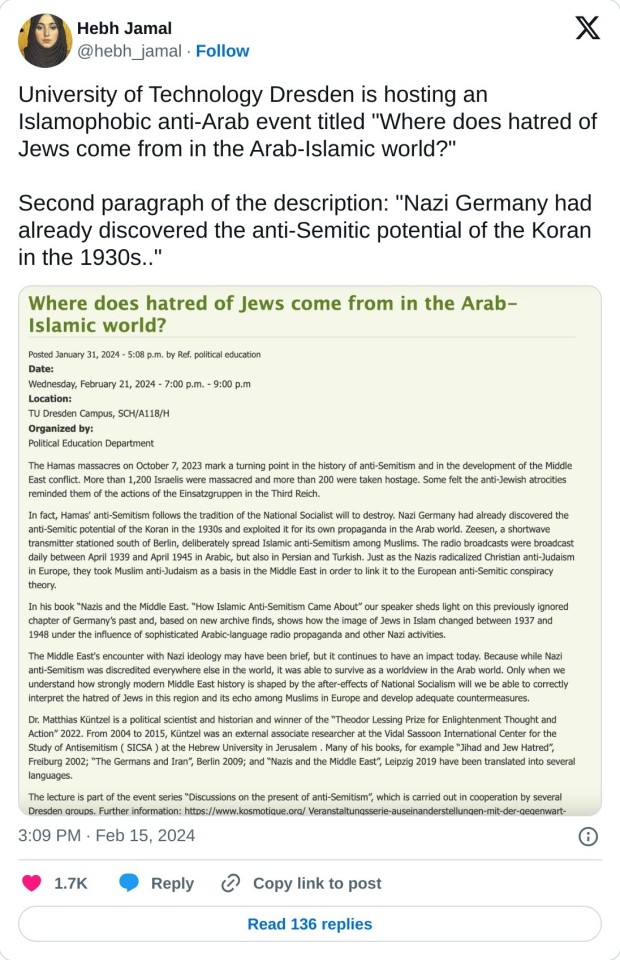
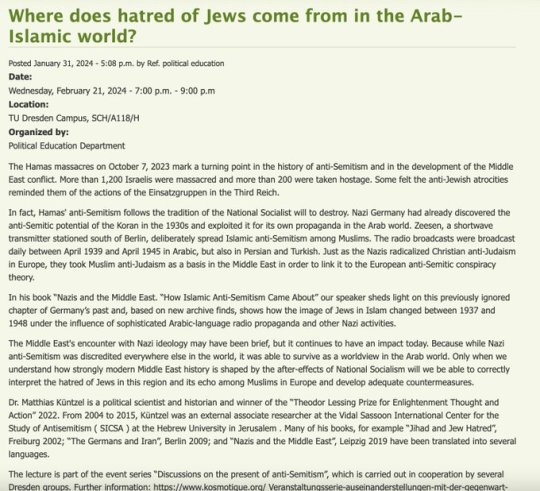
The Hamas massacres on October 7, 2023 mark a turning point in the history of anti-Semitism and in the development of the Middle East conflict. More than 1,200 Israelis were massacred and more than 200 were taken hostage. Some felt the anti-Jewish atrocities reminded them of the actions of the Einsatzgruppen in the Third Reich.
In fact, Hamas' anti-Semitism follows the tradition of the National Socialist will to destroy. Nazi Germany had already discovered the anti-Semitic potential of the Koran in the 1930s and exploited it for its own propaganda in the Arab world. Zeesen, a shortwave transmitter stationed south of Berlin, deliberately spread Islamic anti-Semitism among Muslims. The radio broadcasts were broadcast daily between April 1939 and April 1945 in Arabic, but also in Persian and Turkish. Just as the Nazis radicalized Christian anti-Judaism in Europe, they took Muslim anti-Judaism as a basis in the Middle East in order to link it to the European anti-Semitic conspiracy theory.
In his book “Nazis and the Middle East. “How Islamic Anti-Semitism Came About” our speaker sheds light on this previously ignored chapter of Germany’s past and, based on new archive finds, shows how the image of Jews in Islam changed between 1937 and 1948 under the influence of sophisticated Arabic-language radio propaganda and other Nazi activities.
The Middle East's encounter with Nazi ideology may have been brief, but it continues to have an impact today. Because while Nazi anti-Semitism was discredited everywhere else in the world, it was able to survive as a worldview in the Arab world. Only when we understand how strongly modern Middle East history is shaped by the after-effects of National Socialism will we be able to correctly interpret the hatred of Jews in this region and its echo among Muslims in Europe and develop adequate countermeasures.
Instagram page of the event
#yemen#jerusalem#tel aviv#current events#palestine#free palestine#gaza#free gaza#news on gaza#palestine news#news update#war news#war on gaza#germany#racism#islamophobia#nazism tw
287 notes
·
View notes
Text
Conlanging Issues: A Compendium
NOTE: This question was submitted before the Nov 1, 2023 reopening and may not adhere to all rules and guidelines. The ask has been abridged for clarity.
Most of my questions are about linguistics. […] One of the major locations in my story is a massive empire with cultural inspirations ranging from North Africa in the far south to Mongolia/Russia in the far north […] The middle region is where the capital is and is the main root of culture, from which Ive been taking inspiration from Southwest Asia […], but most notably southern regions of India. I've tried to stick to the way cities are named in Sanskrit-based languages but added the names of stars to the front (because the prevalent religion of this region worships the stars [...]). So Ive ended up with names like Pavoprayag, Alyanaga, Alkaiduru, Alcorpura, Cygnapete, etc. Is this a consistent naming system or should I alter it in some way? The empire itself is named the Arcana Empire since [...] each act of my story is named after a tarot card [...].
Another region in my story is based more on parts of South China and North Vietnam, so I've tried to stick to names with a Chinese origin for that. I understand the significance of family names in southwest [sic] Asia, so I wanted to double check [...]. They have only two short given names. Based on the birth order of the child, the first half of the name comes from the fathers family and the second half from the mothers family. It is seen as disrespectful not to use both names because using only one is seen as denouncing that side of your family. Thus I have names like Su Yin, Dai Jun, and Yi Wen for some of the characters from this region, and the city itself that they are from is named Bei Fen.
On the other hand, Im having further trouble naming characters. […] Ive been trying to give my human characters names from real human cultures to distinguish them from the website-generated names of say, orcs, elves, dwarves, etc, but I think I should change many of the names Ive used to be more original and avoid fracturing real world cultures for the sake of my worldbuilding. […] Im still very weak in the linguistics area (even after four years of French, sigh) and am having trouble finding where to read about naming patterns so I can make new ones up. I read your naming guides but am still having trouble on where to start for specific languages. […] Im trying to look into Sanskrit, Turkish, and Persian specifically.
You're Going Too Broad
In my opinion, you’re casting too wide a net. You mentioned looking into Sanskrit, Turkish, and Persian to develop fantasy names. These languages are very different from one another, so unless you’re using them separately for very different parts of your world, it will be hard to draw inspiration from them in a way that makes sense. You’re taking on a huge amount of research in order to worldbuild cultures that span a massive geographical area (basically all of North Africa and Asia?) and have very little in common. Are you sure you want to take on that task?
I could see it being more manageable if most of your story is set in a small region of this world, which you will then research in depth to make sure you’re being as specific as possible.
Taking Persian as an example, you’ll have to decide whether you want to use Old Persian, Middle Persian, or Modern Persian. Each of these comes with a different alphabet and historical influences. They’re also associated with different periods of time and corresponding cultural and social markers. Once you’ve decided exactly when and where you want to start from, you can then expand the borders of your area of focus. For example, if you’ve decided to draw inspiration from Achaemenid Persia, you can then look at the languages that were spoken in the Achaemenid Empire. A quick Google search tells me that while Old Persian was the empire’s official language, they also used Aramaic, Akkadian, Median, Greek, and Elamite (among, I’m sure, many many others and many more regional variations). Further research into each of these will give you ethnic groups and bordering nations that you can draw more inspiration from to expand out your worldbuilding.
Don’t forget to make sure you’re staying within the same time period in order to keep things consistent. It’s a lot of work, and this is only for a small portion of the continent-spanning worldbuilding you’re trying to do.
You can get away with painting the rest of the continent in broad strokes without too much depth if the story doesn’t go there and you don’t have any main characters from those parts of the world. Otherwise, you’ll need to put this same level of detail into your worldbuilding for the area with Turkish-inspired names, and again for the area with Sanskrit-inspired names, and so on.
I know this isn’t what you were asking, but I honestly have a hard time helping you figure out where to start because your ask is so broad I don’t quite know where I would start myself. So, this is my advice: focus down on one region and time period and go from there. Feel free to write back once you’ve picked a narrower focus that we could help you with.
- Niki
So there’s logistical issues in regards to your naming system for southern China-coded regions. One issue is history: mainly on how there is not simply one language in China but multiple due to having a lot of ethnic groups and the size of China. South China in particular has different dialects and languages than the North as seen in this map of Chinese languages and dialects. There’s also how historically Mandarin was not the official language until 1913 in China and historical China saw vast changes in territory dependent on the dynasty. Before then, Mandarin was primarily a northern Chinese language based in Beijing while southern China had its own languages, dialects, and dynamics. Not to mention, historical China saw an evolution of language just like English has Old English, Middle English, Early Modern English, and Modern English. For instance, Vietnam was once part of China during the Tang Dynasty and at another point, it was not part of China.
-Mod Sci
If You’re Borrowing Whole Words or Elements, Research More
The other issue is inconsistency with the cultures you’re deriving this conlang from. In regards to “two given names,” the Chinese name I was given was one syllable and then I would have a last name that was also one syllable. There’s also how not every family is perfect. Not every marriage is sanctioned and some children may come from single parents. Some families may not cooperate with marriage and sometimes children may be abandoned with unknown parents. There does not seem to be contingencies for these names under this conlang system.
The main problem with conlangs is that one needs to truly understand the languages one is drawing from. Tolkein managed to create conlangs due to training in linguistics. Mandarin is already a difficult language with multiple tones, and trying to use it for conlangs without knowledge of how Mandarin works or a good foundation in linguistics is just a Sisyphean endeavor.
-Mod Sci
Four years of French wouldn’t have taught you about linguistics as a science or anything about the language families you’ve listed - Indo-Iranian, Sino-Tibetan, and Turkic, nor any Asian naming conventions. I agree with Niki that you need to narrow down your research.
Pur/pura means city in Sanskrit (ex: Gurdaspur, Hoshiarpur). Prayag is a place where pilgrimages are done. Naga isn’t a place name in Sanskrit (google says it means snake), nagar is and it means town. X Nagar is a very common name for places (Ex: Rajinder Nagar). Many cities in Karnataka have names ending in uru (Bengaluru, Mysuru, Mangaluru, Tumakuru, etc) but the language of Karnataka is Kannada - a Dravidian language and completely different family from Sanskrit (Indo-Aryan). I’m not sure where “pete” came from. “Bad” and “vaal” are common suffixes for places too (Ex: Faisalabad, Allahabad). A disclaimer that I do not speak Sanskrit, I speak Punjabi, which is a descendant of Sanskrit and in the same linguistic family (Indo-Aryan languages).
- SK
Also, This Is Not…Really Conlanging.
Hi OP. Linguistics refers to the science of studying how languages work, not the discipline of learning languages. And nothing shows that gap more than how you have thus far approached constructing fictional languages and toponyms.
The reason why Sci and SK have a lot to say about your place names is because they don't resonate—you have borrowed whole words into your toponyms (place names) from a variety of languages—without an accurate understanding of what these words mean, how they’re pronounced, where they’re derived from—and expected them to work together. I suggest you read the links below on why conlanging is not as simple as choosing some languages and mashing their IRL words together:
Why Using Random Languages Wholesale in your Fantasy is a Bad Idea
Pitfalls of Mashing Countries and Languages in Coding
In your city names, for example, you’re using star names from multiple languages that use different sets of sounds represented by different sets of historical spelling rules. “Cygn-” and “Arcana” stick out like a sore thumb—the fact that one “c” is /s/ and one is /k/ is an obvious flag that they are Latin-derived English borrowings. This is because spelling rules were created in Middle English to make sense of the mix of “c” pronunciations across words of Indo-European origin due to a historical split called the Centum-Satem division. This is a phenomenon that is very specific to our world history, and to the history of English at that. Ironically, in your attempt to avoid stock fantasy names (which also often fall into the Latin-derived English pit), you are taking the exact same approach to naming.
Like Niki said, your selections are far too broad to code under a single umbrella. Do you expect that whatever language that city name came from runs the full gamut of sound inventory & spelling variety that spans multiple continents and hundreds of languages? Because that’s not how languages work. (And yes, I mean hundreds. Indigenous languages and linguistic diversity are a thing. See Niki’s note about just the languages in Persia. And nation-states bulldozing over those languages and pretending it’s just one language is a thing. See Sci’s note about China.) I haven't even talked about the variation in morphology (how words are formed) or syntax (sentence structure).
Please just read or re-read my guide on “naming conlangs” in this post and start from there.
~ Rina
PSA ON CONLANGING AND FANTASY NAMES:
For fantasy language asks submitted after Nov 1, 2023, the asker must indicate that they have read Mod Rina’s conlanging posts linked in FAQ 2 (Guides and Posts by Topic) of the Masterpost under the question “How do I make a fictional language for my story?” While this is an older ask, we are posting it as an example to our followers.
Per our new rules, any questions that can be directly answered in or extrapolated from the FAQs, or questions that indicate that the relevant resources haven’t been read, will be deleted with a note in the Deletion Log explaining why.
As always, if this post was helpful or educational to you, please consider tipping the relevant mods: SK, Niki, Sci, and Rina.
Edited for terminology errors
321 notes
·
View notes
Text
Famous Jewish royalty and nobility as Disney Princesses:
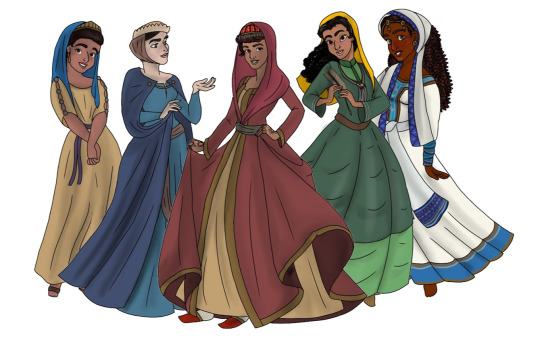
Growing up, I loved Disney Princesses, but I never saw any representation of Jewish princesses. Which was a shame, because I grew up with stories of strong Jewish women, I just never got to see their stories in mainstream media. I have two younger sisters, and I wish they could grow up seeing just one Disney Princess from our culture and heritage. So, being an artist, I decided to take the five classic white princesses, and redesign them to be five strong Jewish royalty and nobility. I decided to represent a large swath of time periods and locations, just like Disney Princess stories cover different time periods and locations, and to celebrate the diversity of Jewish history. So, let's go!

Queen Esther
For Cinderella, I chose to depict Queen Esther, because they both share themes of concealing one's identity. Esther is the heroine of Megillat Esther, a book in the Tanakh. She was forced to become the wife of the Persian king Achashverosh, but because of it she was able to save the Jewish people from genocide at the hands of Haman. Queen Esther might be a "typical" choice, but I think that not many people truly appreciate her and her story, despite how well-known it is.

Qasmuna
For Belle, I chose the poet Qasmuna, because Belle is a studious woman, and Qasmuna was a scholar and a poet. Qasmuna was an Arabic-language Andalusian poet during the middle ages. Not much is known about her, but she is one of the very few recorded Jewish Arabic-language poets of her time. Some sources attribute her to having been the vizier Shmuel HaNagid (Samuel Ibn Nagrillah)'s daughter, making her the closest to royalty as was possible for a Dhimmi at the time. I depicted her wearing lavish clothing, but also wearing a yellow shawl and a gold calf necklace to signify her Dhimmitude.

Licoricia of Winchester
For Aurora, I chose to depict Licoricia of Winchester since Disney's Sleeping Beauty takes place in England. Licoricia was a 13th century English businesswoman and community leader. She funded and lent money to prominent gentile figures at the time, including King Henry III. She is considered one of the most influencial Jewish women in her time. She was murdured, possibly in a robbery, but her murderer had never been found or held accountable. I based her outfit off of the recently unvailed statue of her in Winchester, England.

Queen of Sheba
For Ariel, I chose to depict the Queen of Sheba, since they both traveled long ways to a different place. The Queen of Sheba is mentioned in the Tanakh and Apocrypha, as well as folktales. She traveled to the Kingdom of Israel to meet King Shlomo and test his wisdom. Many have attributed her to being the woman voice in Shlomo's Song of Songs. She was a powerful and wealthy leader, and almost managed to best Shlomo in knowledge. According to tradition, she converted to Judaism and travled back to Ethiopia and led her people towards Judaism.
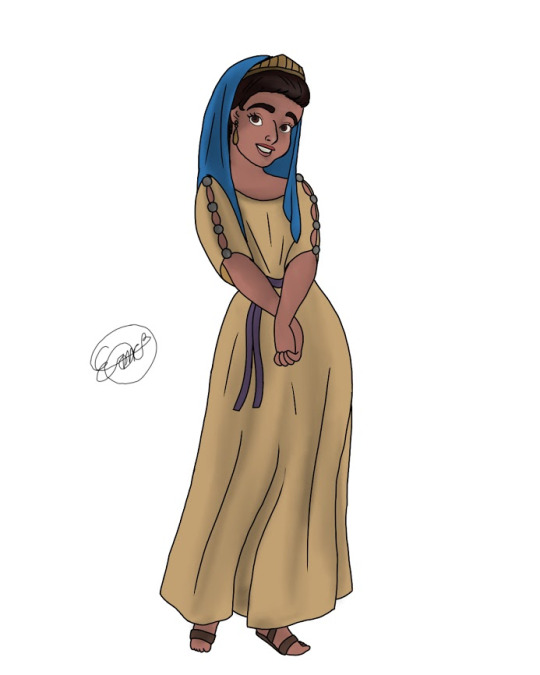
Queen Shelmazion
For Snow White, I chose to depict Queen Shelamzion. Queen Shelamzion was one of the last independent Jewish rulers of Judea before the total Roman takeover. Roman sources absolutely smeared her name, likely because Shelamzion was a powerful Jewish woman who opposed the Roman occupation. However, Shelamzion was a good rular, who attempted to make peace among her people, and is credited with saving seventy sages from Roman slaughter. It is said that because of her righteousness, during her rule, it rained only on Shabbat so that farmers would not miss out on needed worktime due to the rain, since they weren't working on Shabbat anyway, and that the harvest in Judea were always bountiful.
I hope you learned something and appreciate my depictions of Jewish Disney Princesses :)
I have a ko-fi if you'd like to tip, but there's absolutely no obligation.
[id in alt text]
#judaism#jumblr#jewish women#disney princesses#queen esther#qasmuna#licoricia of winchester#queen of sheba#queen shelamzion#jewish history#jewish women appreciation#my art#digital art#jewish art#education
3K notes
·
View notes
Text
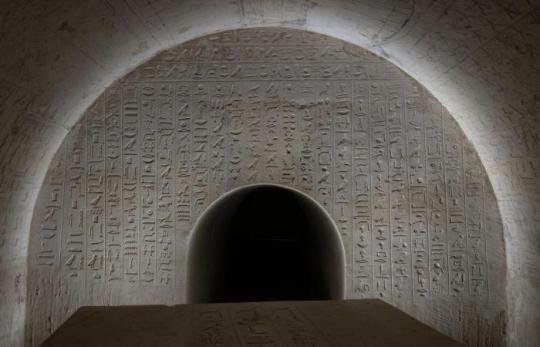
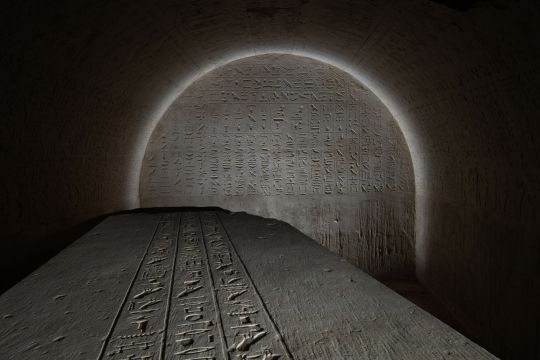
The Tomb of a Royal Scribe Discovered in Egypt
Czech experts have made another important discovery in the Egyptian archaeological site in Abusir. They found the hitherto unexplored tomb of the royal scribe Dzhehutiemhat, which is richly decorated in the form of many hieroglyphic texts and images. They mainly consist of ritual and religious texts, which were supposed to ensure the soul of the deceased an eternal life in the next world.
In April and May of this year, another part of field research by Czech Egyptologists regarding shaft tombs from the middle of the first millennium BC took place in Abusir, Egypt. It was here that the archaeological team of the Czech Institute of Egyptology of the Faculty of Arts of Charles University discovered the tomb of a hitherto unknown dignitary from the time of the Persian invasion of Egypt.
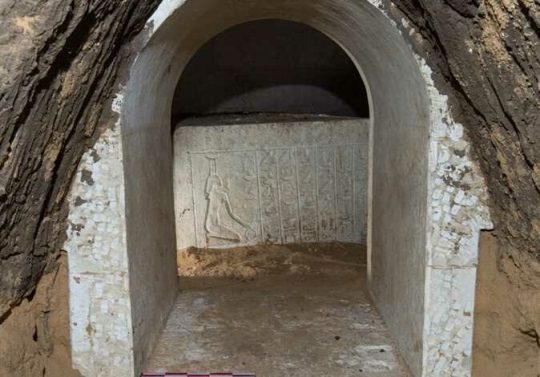

“It is a richly decorated shaft tomb of medium size, whose owner, a certain Džehutiemhat, held the office of royal scribe,” explains Ladislav Bareš, who has been coordinating the research of Abusir shaft tombs for a long time.
From the tomb, the above-ground part of which was destroyed already in ancient times, only the main shaft was preserved, at the bottom of which lay a burial chamber made of limestone blocks at a depth of 14 meters. Access to it was provided by a small, more northerly shaft and a narrow corridor approximately three meters long connecting the access shaft with the burial chamber.
For reasons still unknown, this access shaft was largely filled with several dozen decorated limestone blocks, originating from the dismantled above-ground part of the nearby majestic tomb of General Menechibnekon.
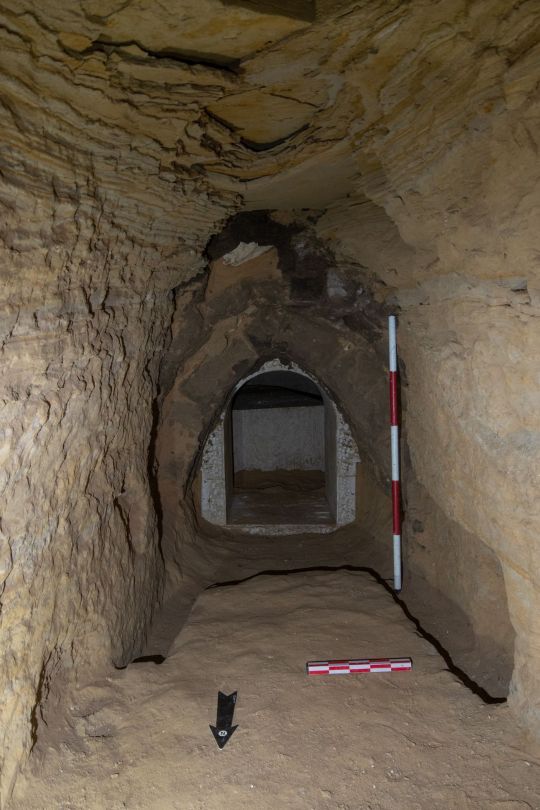
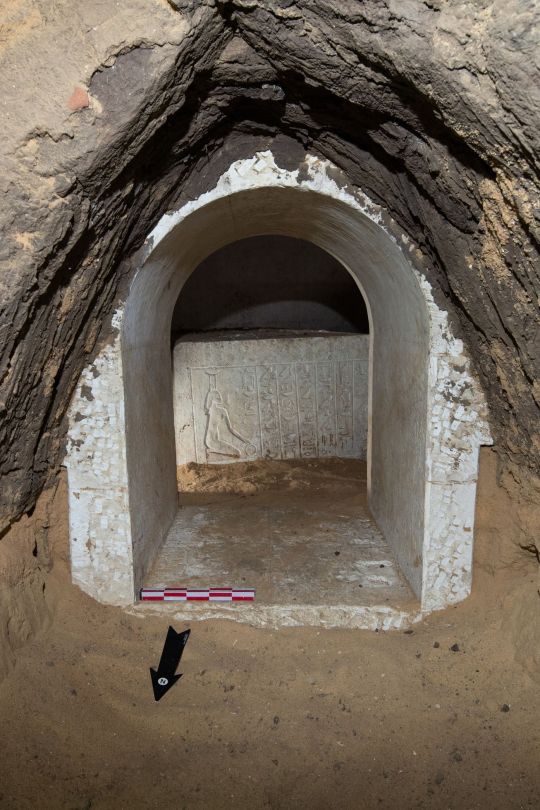
A tomb with rich decoration
The burial chamber is richly decorated with texts and other scenes. A long sequence of incantations against snakebite from the Pyramid Texts covers the north entrance wall. Interestingly, the snakes mentioned in these magical texts represented a potential danger, but could also serve as powerful protectors of the deceased and his mummy.
“While the entrance to the nearby Menechibnekon’s burial chamber was protected by the guardians of the gates of the 144th chapter of the Book of the Dead, in the case of Džehutiemhat, snakes from the Pyramid Texts play this role,” adds Renata Landgráfová, director of the Institute of Egyptology and an expert on the ancient Egyptian language and texts.
The south and west walls are covered with a sacrificial ritual and an extensive sacrificial list. On the ceiling of the burial chamber are depictions of the journey of the sun god Reo through the sky, first in the morning and then in the evening celestial bar. The depictions are accompanied by hymns to the rising and setting sun.
Inside the burial chamber covered with relief decoration is a large stone sarcophagus, which also bears hieroglyphic inscriptions and depictions of gods, both outside and inside. The lid is decorated with texts taken from the Book of the Dead, but also excerpts from the much older Pyramid Texts, which partially repeat sayings that also appear on the walls of the burial chamber.
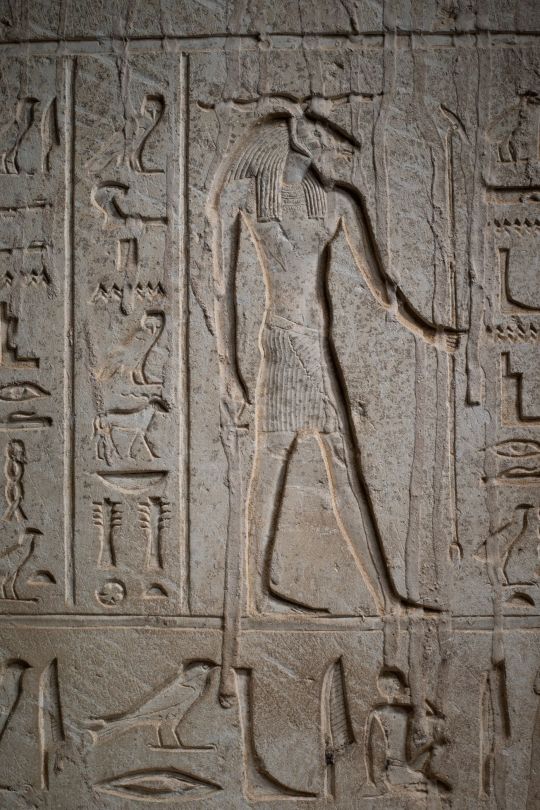
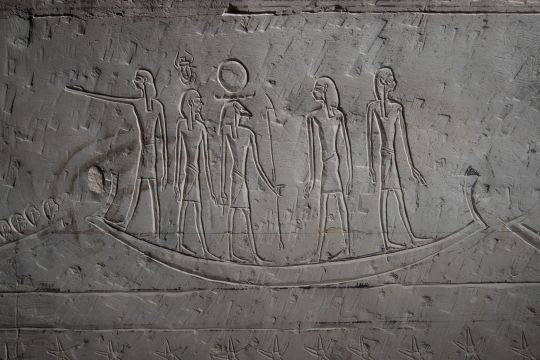
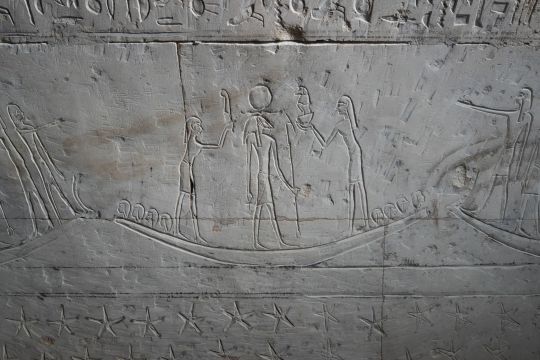
Ritual texts for eternal life
On the bottom of the inner wall of the sarcophagus bath, the goddess of the west, Imentet, is depicted, and its inner sides bear the so-called canopic sayings, spoken by this goddess and the earth god Geb. “The goddess of the west inside the sarcophagus represents the protector, guide and symbolic mother of the deceased,” explains Jiří Janák, who analyzes and interprets religious and magical texts as part of field research.
All the mentioned spiritual-ritual texts were supposed to ensure the deceased a smooth entry into a blissful and well-secured eternal life in the afterlife.
The tomb of the scribe Dzhehutiemhat was discovered almost empty, as it was robbed probably already in the 5th century AD, similar to other tombs in this burial ground.
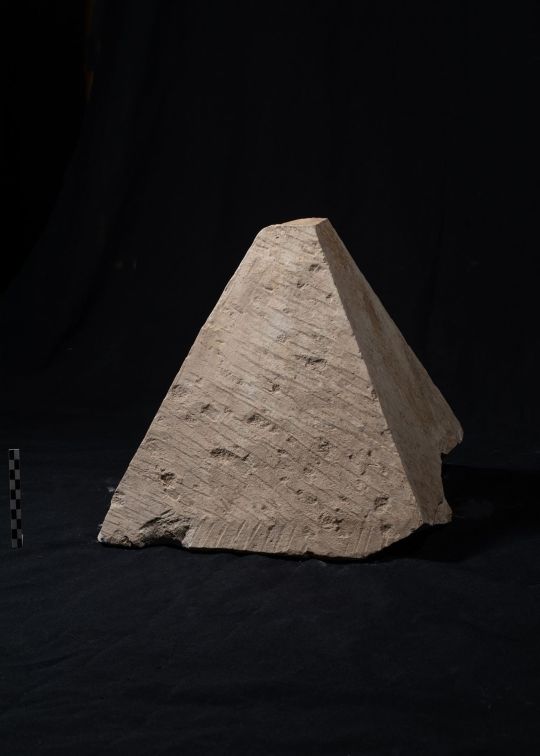
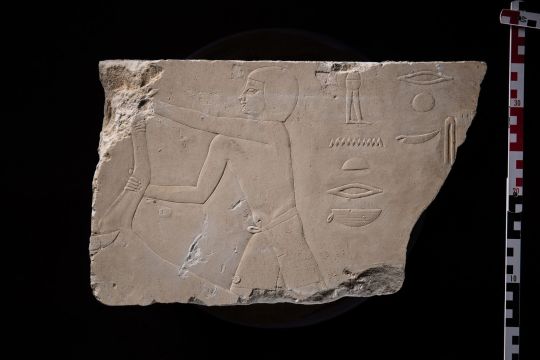

The deceased suffered from sedentary work
From the anthropological analysis of the skeletal remains, which was carried out by leading Egyptian experts, it was found that Dzhehutiemhat died at a relatively early age of around 25 years, he bore the signs of a kind of occupational disease (wear and tear of the spine during sedentary work) and suffered from severe osteoporosis, i.e. thinning of the bones.
The latter fact could place him in the family of other inhabitants of the Abusir shaft tomb burial, in whom the disease was also confirmed, such as the famous Iufaa, the owner of a nearby much larger tomb, whose unlooted burial chamber was discovered in 1996.
It is therefore possible that most of the owners of the tombs buried in this part of the Abusir necropolis belonged to one extended family, firmly anchored in the military elite of late Saiyan Egypt. However, Dzhehutiemhat’s mother probably came from completely different circles and a different part of Egypt at that time. Her two names can be translated as “Nubian” and “Fox”, while the latter is written in an unusual, most likely Berber form.
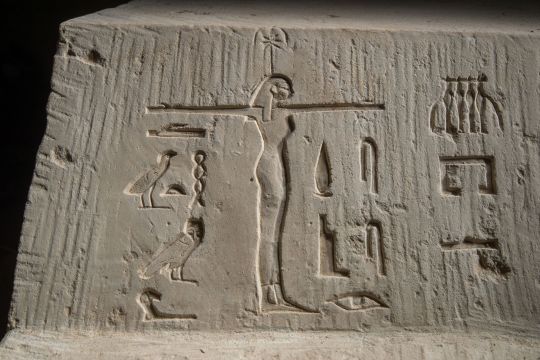
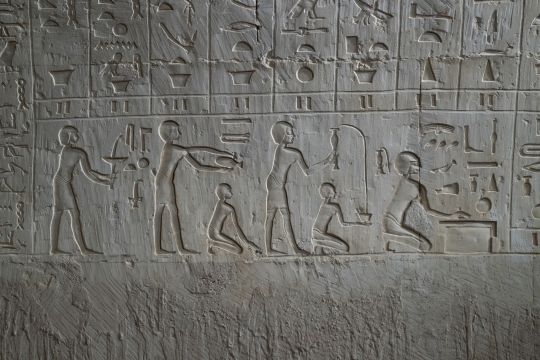
They also found a collection of pottery in the tomb. “The discovery of a large fragment of a Chian amphora with a perfectly smoothed edge is also very interesting, because the ancient looters probably used it as a shovel,” says Květa Smoláriková, who is an expert on Egyptian ceramics and Greek imports in the Czech team.
“The recently discovered tomb of the dignitary Džehutiemhat on the Abusír archaeological concession is the latest piece of knowledge in the mosaic of the history of ancient Egypt at the end of its glory in the late period, in the 6th century BC,” says Miroslav Bárta, director of Czech archaeological research in Abusír, about the discovery.
“The shaft tombs represent a special type of tombs of this time. They were created as a specific attempt by the ancient Egyptian elites for a renaissance and are based on the form of the tomb of King Djoser, the founder of the famous Old Kingdom, the time of the pyramid builders in the 3rd millennium BC,” he adds.


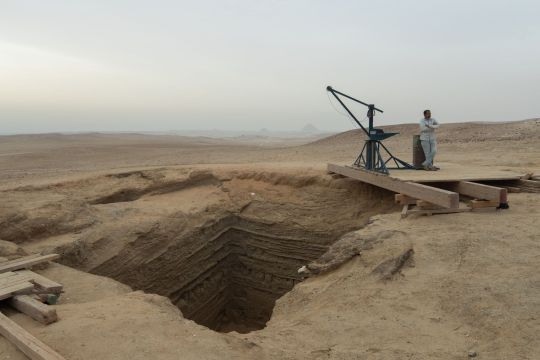
#The Tomb of a Royal Scribe Discovered in Egypt#Abusir Egypt#Dzhehutiemhat#first millennium BC#ancient tomb#ancient grave#ancient artifacts#burial chamber#Czech Institute of Egyptology#archeology#archeolgst#history#history news#ancient history#ancient culture#ancient civilizations#ancient egypt#egyptian history#egyptian art#long reads
277 notes
·
View notes
Photo
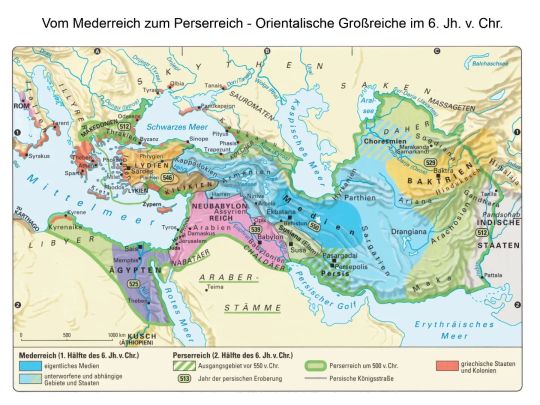
West Asian empires in the 6th century BC
“TaschenAtlas – Weltgeschichte”, Klett-Perthes Verlag, 2004
via cartesdhistoire
According to Herodotus ("Histories", Book I), Deioces became king of the Medes in 701 BCE in western Iran. He united the six Median tribes and repelled Assyria's influence from his capital, Ecbatana. His grandson Cyaxares destroyed the Assyrian Empire with the help of the Babylonians (612 BCE), and then they divided its remnants. Cyaxares also destroyed the kingdoms of the Mannaeans and Urartu and advanced into Asia Minor, where the Halys River became the border with Lydia (585 BCE). His son Astyages succumbed to the Persians in 550 BCE, and Media became a satrapy.
In western Media, Nabopolassar founded the Chaldean dynasty ruling over the Neo-Babylonian Empire (625-539 BCE). His son Nebuchadnezzar II (605-562 BCE) restored Babylonian greatness and built the Temple of Marduk (the biblical Tower of Babel) in his capital, as well as the fortifications known as the "Median Wall," palaces, and the Hanging Gardens (on terraces). In 539 BCE, the Persians seized Babylon.
Achaemenid Persian Cyrus II conquered the Median Empire, Lydia (546 BCE), Babylon (539 BCE), and the Greek cities of western Asia Minor, Bactria, and Sogdia (529 BCE). His son Cambyses II subjugated Egypt and the Greek cities of Cyrenaica (525 BCE). The Persians then adopted the Assyrian concept of an empire uniting all the peoples of the world under one great king ("King of Kings"). Darius I conquered the Indus Valley in 512 BCE and occupied Thrace and Macedonia (513 BCE).
The Assyrians and Chaldeans had already begun to politically and civilly unify much of the Middle East, and the Persians continued this tradition. Thus, Aramaic, already used as a language of communication, was adopted as the language of Persian administration.
Despite its power, the history of the Achaemenids is poorly known because the scribes used parchment or papyrus; apart from rare royal inscriptions, there are few accounts from reluctant subjects or passionate opponents.
73 notes
·
View notes
Text
"Attar is one of the greatest poets of the Persian language. Nonetheless, his popularity - both in Iran itself and in the West (Goethe, for example, touched on him only briefly in his West-Eastern Divan) - does not match that of Ferdowsi (d. 1020), Omar Khayyam (d. c.1132), Rumi, Saadi (d. 1292) or Hafiz (d. 1389); occasionally he is even omitted from the line of seven Persian poet-princes in favour of Jami (d. 1492). One possible reason for this is that the composition of his poetry is too artful, too complex to be effective in the town squares and teahouses, while at the same time, many of his stories and figures may seem too coarse, too folk-like and too sarcastic to be at the forefront of the high spiritual literature cultivated at courts in former times and in middle-class households today. Attar’s poetry, on the other hand, is far less stilted than that of most Persian poets but, rather, unadorned, clear and immediate. The pain it expresses is not spiritually filtered as in Rumi, far less metaphysically elevated than in Saadi, and not sublimated into pleasure as in Omar Khayyam - where Hafiz turns the earthly into the mystical, Attar strips mysticism down to its leaden, earthly foundation in order to scream his longing to the heavens."
--Navid Kermani, The Terror of God: Attar, Job and the Metaphysical Revolt
.
I asked my professor which masnavi (Persian epic poem) he thinks is the greatest ever written. He replied, Rumi's Masnavi (the only masnavi Rumi wrote). Shock. How can there be a masnavi greater than Attar's Conference of the Birds? (There are 4 authentic Attar masnavis; sadly, as far as I know, Conference of the Birds is the only one that has been translated into English.) Reading through Rumi's masnavi I think I am still team Attar. It's Attar's coarseness I love--he is a poet of mad saints and freaks. In Rumi's Masnavi, the absence of a frame story and the pious/didactic tone is somewhat of a barrier for me. The pieces don't quite hang together, whereas Attar's Conference of the Birds is intricately structured--there are stories within stories within stories, each bird with its idiosyncratic psychology--a narrative arc that mirrors the journey of the soul across the seven valleys. But maybe there is a difference between reading a sufi text for its poetry rather than religious instruction, I don't know.
#attar#Rumi#persian poetry#poetry#literature#masnavi#Navid Kermani#islam#islamic mysticism#islamic literature#mysticism#sufism#sufi literature
192 notes
·
View notes
Text
“That year, using English as an example, they began the task of studying how languages grew, changed, morphed, multiplied, diverged, and converged. They studied sound changes; why the English knee had a silent k that was pronounced in the German counterpart; why the stop consonants of Latin, Greek, and Sanskrit had such a regular correspondence with consonants in Germanic languages. They read Bopp, Grimm, and Rask in translation; they read the Etymologiae of Isidorus. They studied semantic shifts, syntactical change, dialectical divergence, and borrowing, as well as the reconstructive methods one might use to piece together the relationships between languages that at first glance seemed to have nothing to do with each other. They dug through languages like they were mines, searching for valuable veins of common heritage and distorted meaning.
It changed the way they spoke. Constantly they trailed off in the middle of sentences. They could not utter even common phrases and aphorisms without pausing to wonder where those words came from. Such interrogations infiltrated all their conversations, became the default way they made sense of each other and everything else. They could no longer look at the world and not see stories, histories, layered everywhere like centuries’ worth of sediment.
And the influences on English were so much deeper and more diverse than they thought. Chit came from the Marathi chitti, meaning ‘letter’ or ‘note’. Coffee had made its way into English by way of Dutch (koffie), Turkish (kahveh), and originally Arabic (qahwah). Tabby cats were named after a striped silk that was in turn named for its place of origin: a quarter of Baghdad named al-‘Attābiyya. Even basic words for clothes all came from somewhere. Damask came from cloth made in Damascus; gingham came from the Malay word genggang, meaning ‘striped’; calico referred to Calicut in Kerala, and taffeta, Ramy told them, had its roots in the Persian word tafte, meaning ‘a shiny cloth’. But not all English words had their roots in such far-flung or noble origins. The curious thing about etymology, they soon learned, was that anything could influence a language, from the consumption habits of the rich and worldly to the so-called vulgar utterances of the poor and wretched. The lowly cants, the supposed secret languages of thieves, vagabonds, and foreigners, had contributed such common words such as bilk, booty, and bauble.
English did not just borrow words from other languages; it was stuffed to the brim with foreign influences, a Frankenstein vernacular. And Robin found it incredible, how this country, whose citizens prided themselves so much on being better than the rest of the world, could not make it through an afternoon tea without borrowed goods.”
— RF Kuang, Babel
2K notes
·
View notes
Text
LANGBLR INTRO!!!

A little about me:
Call me Azara c:
Middle Eastern - Persian origins (not ir*nian please ;-;)
26 - isfp - sagittarius
lesbian - she/her
Got my BA in English Language and Literature with a minor in French
Preparing for an MA in Teaching English as a Foreign Language and self-studying and researching theoretical+applied+interdisciplinary linguistics

Languages I speak:
Arabic (native - standard and a dialect of the gulf)
Farsi (native but I don't speak the standard)
English C1
French (standard) B1/B2
Korean B1/B2

Languages Goals - short and long term:
IELTS BAND 9
Arabic (build my vocabulary for translation)
Advancing in Korean C1
Advancing in French C1
Learning Standard Farsi
Consistently learn Japanese for 60 days
Consistently learn Chinese for 60 days
Could post about other languages that interest me at one point!

How I learn languages
tv shows mostly as I rely a lot on pronunciation and sentence structures in speech
music - I mostly listen to English, Persian, Korean, Japanese and French songs but I am open to anything as long as it's good
used to take classes before covid and then I enrolled in online classes and hated them - they were bland.
textbooks that I spent a fortune on ;-;
Let's be friends !! ♡
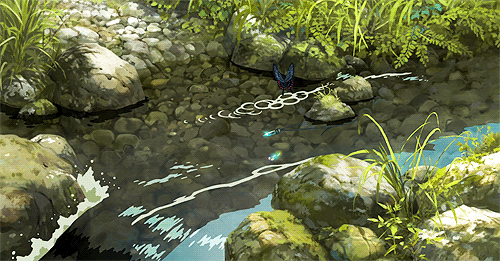
#langblr intro#language learning#language#langblr#french langblr#japanese langblr#korean langblr#farsi langblr#arabic langblr#chinese langblr#mandarin langblr#academia#languages
104 notes
·
View notes